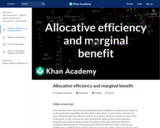
Marginal Utility and maximization. Created by Sal Khan.
- Subject:
- Economics
- Social Science
- Material Type:
- Lesson
- Provider:
- Khan Academy
- Provider Set:
- Khan Academy
- Author:
- Sal Khan
- Date Added:
- 07/27/2021

Marginal Utility and maximization. Created by Sal Khan.

The fact of scarcity forces individuals, firms, and societies to choose among alternative uses – or allocations – of its limited resources. Accordingly, the first part of this summer course seeks to understand how economists model the choice process of individual consumers and firms, and how markets work to coordinate these choices. It also examines how well markets perform this function using the economist’s criterion of market efficiency.
Overall, this course focuses on microeconomics, with some topics from macroeconomics and international trade. It emphasizes the integration of theory, data, and judgment in the analysis of corporate decisions and public policy, and in the assessment of changing U.S. and international business environments.

This course focuses on the origins, functions, and implications of downtown management organizations (DMOs), such as business improvement districts, in a variety of national contexts including the United States, Canada, South Africa, and the United Kingdom. It critically examines how a range of urban theories provide a rationale for the establishment and design of DMOs; the evolution and transnational transfer of DMO policy; and the spatial and political externalities associated with the local proliferation of DMOs. Particular emphasis is given to the role of DMOs in securing public space.

This half semester class will present an introduction to macroeconomic modeling, particularly economic growth. It will focus both on models of economic growth and their empirical applications, and try to shed light on the mechanics of economic growth, technological change and sources of income and growth differences across countries.
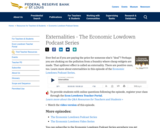
Ever feel as if you are paying the price for someone else's "deal"? Perhaps you are choking on the pollution from a foundry where cheap widgets are made. That spillover effect is called an externality. There are positive ones, too.

In this video (6 minutes long) students will learn about how externalities can affect supply, demand and ultimately equilibrium. This video will aid in review of standard EFP. 3 since students will see how a supply and demand graph can shift as a result of costs / benefits of externalities.

This course is a survey of modern macroeconomics at a quite advanced level. Topics include the neoclassical growth model, overlapping generations, endogenous growth models, business cycles, incomplete nominal adjustment, incomplete financial markets, fiscal and monetary policy, consumption and savings, and unemployment. The course is also an introduction to the mathematical tools used in modern macroeconomics, including dynamic systems, optimal control, and dynamic programming.
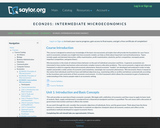
This course is designed to extend the student's knowledge of the basic microeconomic principles that will provide the foundation for their future work in economics and give them insight into how economic models can help us think about important real world phenomena. Topics include supply and demand interaction, utility maximization, profit maximization, elasticity, perfect competition, monopoly power, imperfect competition, and game theory. Upon successful completion of this course, the student will be able to: Explain the standard theory in microeconomics at an intermediate level; Explain and use the basic tools of microeconomic theory, and apply them to help address problems in public policy; Analyze the role of markets in allocating scarce resources; Explain both competitive markets, for which basic models of supply and demand are most appropriate, and markets in which agents act strategically, for which game theory is the more appropriate tool; Synthesize the impact of government intervention in the market; Develop quantitative skills in doing economic cost and consumer analysis using calculus; Compare and contrast arguments concerning business and politics, and make good conjectures regarding the possible solutions; Analyze the economic behavior of individuals and firms, and explore how they respond to changes in the opportunities and constraints that they face and how they interact in markets; Apply basic tools that are used in many fields of economics, including household economics, labor economics, production theory, international economics, natural resource economics, public finance, and capital markets. (Economics 201)
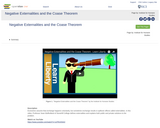
Economics assume that exchange happens voluntarily, but sometimes exchange results in spillover effects called externalities. In this video, Professor Sean Mullholland of Stonehill College defines externalities and explains both public and private solutions to the problem.
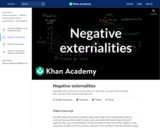
Taking negative externalities into account when thinking about the optimal equilibrium price and quantity. Created by Sal Khan.
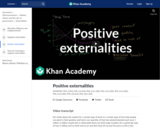
What happens when all of the benefits of consumption are not captured in a demand curve? In this video we explore how to think about positive externalities in a market setting. Created by Sal Khan.

Explainer Video about Consumption and Sustainability

This introductory undergraduate course covers the fundamentals of microeconomics. Topics include supply and demand, market equilibrium, consumer theory, production and the behavior of firms, monopoly, oligopoly, welfare economics, public goods, and externalities.
Chalk Radio Podcast
Prof. Jonathan Gruber was featured in an episode of OpenCourseWare’s podcast, Chalk Radio. In the episode “Thinking Like an Economist,” Prof. Gruber talks about how he engages students in 14.01 with accessible real world examples. Listen to the episode on Apple Podcasts.
MITx Online Version
This course is part of the Micromaster’s Program in Data, Economics, and Design of Policy through MITx Online. The course is entirely free to audit, though learners have the option to pay a fee, which is based on the learner’s ability to pay, to take the proctored exam, and earn a course certificate. To access the course, create an MITx Online account and enroll in the course 14.100x Microeconomics.
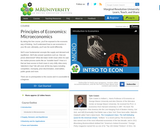
With this free video resource, students will be exposed to the economic way of thinking. Students will understand how to use economics in their lives and, ultimately, you’ll see the world differently-- all through engaging Hollywood production style videos.
Educators can use MRU's videos in a variety of ways, to include “flipping” the classroom, as study aids, supplementary material, concept reinforcement, or even as a full course offering.
In MRU's Principles of Microeconomics course, covers fundamental concepts like supply and demand and equilibrium. We also answer questions such as: How are prices determined? What did Adam Smith mean when he said the market process works like an “invisible hand”? How is it that we have access to fresh roses in very cold cities every Valentine’s Day? All key topics are covered to include competition, monopoly, price discrimination, externalities, public goods and more.
There are no prerequisites for this course, and it is accessible to beginners.
------------------------------------
What is Marginal Revolution University (MRU)?
Many of us can remember our first great economics teacher who fundamentally changed how we see the world. At MRU, we try and deliver that experience to millions worldwide through video.
Founded as a nonprofit in 2012 by George Mason University economics professors Tyler Cowen and Alex Tabarrok, MRU is building the world’s largest online library of free economics education videos -- currently weighing in at more than 800 videos.

Explores the role of government in the economy, applying tools of basic microeconomics to answer important policy questions such as government response to global warming, school choice by K-12 students, Social Security versus private retirement savings accounts, government versus private health insurance, setting income tax rates for individuals and corporations.
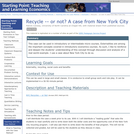
A case for the analysis of externalities (social costs and benefits) in the context of recycling. Drawn from a program in New York City.
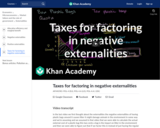
How to factor in negative externalities through taxation. Created by Sal Khan.

What is economics and why should you spend your time learning it? After all, there are other disciplines you could be studying, and other ways you could be spending your time. As the Bring it Home feature just mentioned, making choices is at the heart of what economists study, and your decision to take this course is as much an economic decision as anything else.
Economics is probably not what you think it is. It is not primarily about money or finance. It is not primarily about business. It is not mathematics. What is it then? It is both a subject area and a way of viewing the world.

This readings-based course analyzes the structure and operation of government systems in developing countries, with particular emphasis on regional and local governments. Major topics include: the role of decentralization in national economic reform programs, the potential impact of decentralized governments on local economic development, determination of optimal arrangements for sharing fiscal responsibilities among levels of government, evaluation of local revenue and expenditure decisions, and assessment of prospects and options for intergovernmental fiscal reform. Emphasis is on basic economic concerns, with consideration given to political, institutional, and cultural factors.